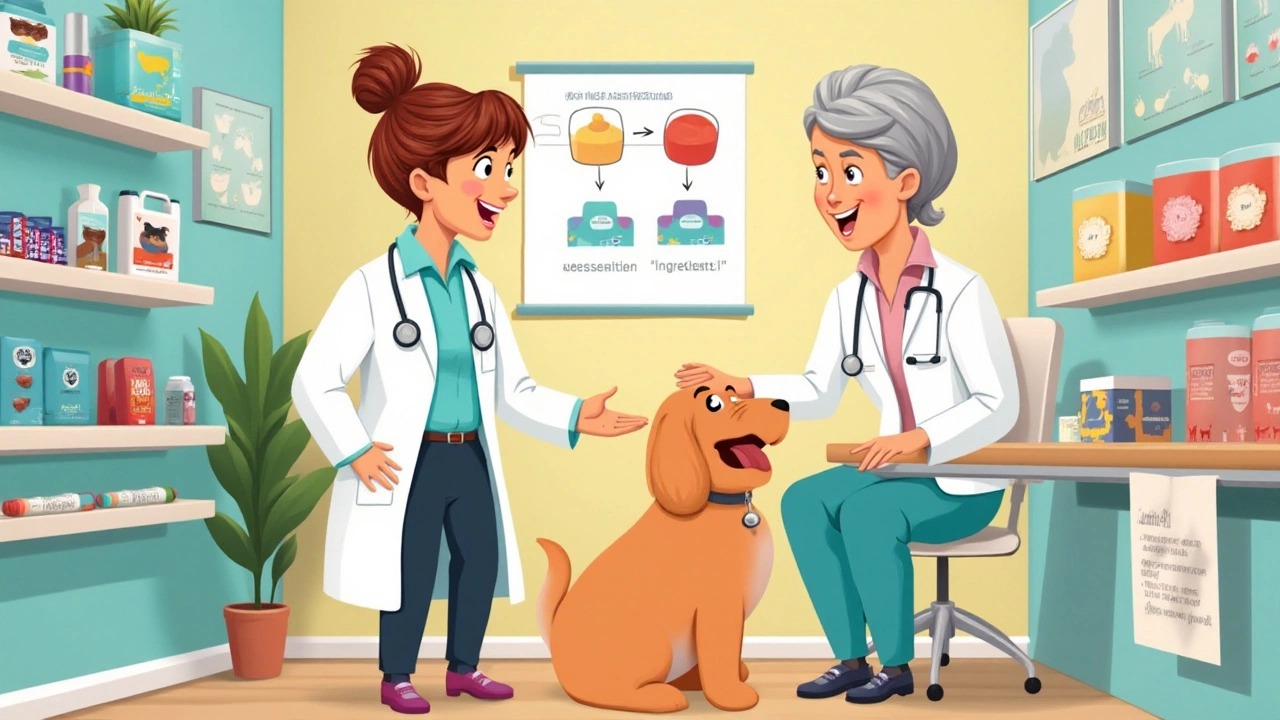You've probably noticed the sheer variety of dog foods available on store shelves, each boasting unique formulas and health benefits. However, amidst all these options, one ingredient stands out as truly essential for your canine companion's nutritional health: protein. While carbohydrates and fats have their place, protein is the cornerstone of any balanced dog diet. It's the building block for growth, tissue repair, and overall vitality.
Understanding the importance of protein isn’t just for the chemists or nutritionists among us; every dog owner should appreciate its role in supporting a strong, energetic, and healthy dog. This guide will take you through why it should always be the first ingredient on a dog food label, what types of protein are most beneficial, and how to navigate the marketing minefield to ensure you're making the best choice for your furry friend.
- Why Protein is King
- The Role of Quality Protein Sources
- Spotting a Good Dog Food
- Misleading Labels and Marketing Tactics
- The Impact on Your Dog’s Health
- Making Informed Choices
Why Protein is King
Dogs are descendants of wolves, and although domestication has changed many aspects of their diet, their fundamental nutritional needs remain similar. At the heart of these needs is protein, which plays an unparalleled role in your dog's health. Proteins are made of amino acids, which are the building blocks of life, crucial for repairing tissues and building cells. This is why protein should be the number one priority in any dog food.
Building Blocks and Beyond
Amino acids obtained from protein are essential for maintaining muscle health, forming new skin cells, and even producing necessary hormones and enzymes. Out of the 22 amino acids dogs require, over half are considered 'essential,' meaning they cannot synthesize these on their own and must obtain them from food sources. Some of these essential amino acids include leucine, lysine, and valine—all important for maintaining muscle integrity and cellular function.
Not All Proteins Are Created Equal
While all dog foods contain some form of protein, the source and quality of these proteins can vary dramatically. Look for specific meat sources (e.g., chicken, beef, lamb) listed as the primary ingredient. These are more likely to offer complete proteins, which provide all the essential amino acids in diet-proportionate amounts. Additionally, some brands may use meat by-products, which typically contain lesser quality protein and more connective tissue.
Protein Requirements: More Than Just a Number
The protein needs of dogs can vary depending on age, activity level, and health status. For instance, puppies require more protein than adults to support rapid growth, whereas highly active adult dogs, such as working or sporting breeds, may need higher protein intake than their more sedentary counterparts. Recognizing this, it's crucial to understand the specific protein content necessary for your dog's stage of life and lifestyle.
Here's a quick guideline on daily protein requirements:
| Dog Type | Total Protein Requirement (%) |
|---|---|
| Puppies | 22% |
| Adult Dogs | 18% |
| Highly Active Dogs | 25%-30% |
Remember, these are broad recommendations, and precise needs can be adjusted with the help of a veterinarian.
The Bottom Line
Concentrate on high-quality protein sources for your pet’s diet to ensure they live their happiest, healthiest lives. This means evaluating dog foods with a discerning eye, focusing on where the protein comes from, and ensuring it meets your healthy dog's biological needs. With the right protein, coupled with balanced nutrition, your dog can enjoy a life full of vitality and vigor.
The Role of Quality Protein Sources
In the world of canine nutrition, not all proteins are created equal. While the term 'protein' might appear frequently on dog food labels, the source of this protein is critical to ensuring your dog receives the nutritional benefits they need. Distinguishing between high-quality and low-quality protein sources can be the difference between a thriving pet and one just getting by. But how do we identify these quality sources?
Animal Proteins: The Gold Standard
Veterinarians and nutritionists agree that animal proteins are one of the best sources for dogs. Meat, poultry, and fish are at the top of the list because they contain all the essential amino acids dogs require for muscle development and tissue maintenance. Ingredients like chicken, beef, and salmon provide not just protein, but vital vitamins and minerals that aid in your dog’s overall health. While plant-based proteins can supplement these sources, they often lack the complete amino acid profile.
Identifying Quality on Labels
When scanning the dog food aisle, it’s essential to look for whole meats listed early in the ingredient list. Ingredients like 'deboned chicken' or 'beef' signal a high-quality source. Conversely, terms like 'meat by-products' or 'bone meal' indicate lower-grade options that are best avoided if you aim for optimal nutrition.
How Protein Quality Impacts Health
A diet rich in high-quality protein ensures your dog has a shiny coat, strong nails, and lean muscles. It bolsters their immune system and supports critical functions like hormone and enzyme production. Furthermore, quality proteins contribute to better digestion and can help mitigate allergic reactions, which are often exacerbated by filler ingredients found in lower-quality foods. Did you know that studies have shown dogs on high-quality protein diets often exhibit increased energy levels and longevity?
Balancing the Protein Content
While protein is critical, balance is crucial. Puppies, active breeds, and nursing dogs require more protein than more sedate or senior dogs. Aim for dog foods where protein content makes up around 18% of dry matter for adult dogs, while puppies and active breeds thrive with 22% or more.
- Ensure whole meats or eggs are primary ingredients.
- Be wary of ambiguous terms like 'meat meal.'
- Consult with a vet to tailor your dog’s protein intake based on their life stage and activity level.
By focusing on the quality of protein sources in your dog's diet, you enhance their chance of leading a healthy, vigorous life. And truthfully, when we're talking about our best friends, is anything less than their best even an option?
Spotting a Good Dog Food
When you're on the hunt for the perfect dog food, the first thing to examine is the ingredient list. But with the myriad of options screaming for your attention, how do you sift through the noise? Whether you're decoding packaging or perusing online reviews, let's take a closer look at strategies to ensure you're selecting the best option for your furry friend.
Read the Label
The first ingredient on the list should ideally be a high-quality source of protein. Look for terms like chicken, beef, or salmon. If the first ingredient is a by-product or filler, keep searching. This is key in providing real nourishment and energy for your dog.
Avoid Fillers and Artificial Additives
Dog food should be free of unnecessary fillers like corn syrup, grain fragments, and artificial colors or flavors, all of which can negatively affect health over time. Opt for recipes that have wholesome, natural ingredients.
Check for Balanced Nutrition
A well-rounded dog food will also address all nutritional needs, incorporating vitamins, minerals, and fats in appropriate proportions. AAFCO (Association of American Feed Control Officials) nutritional adequacy statements on packaging can be a good benchmark as they ensure the food meets the basic nutritional criteria.
Key Components:
- Protein: Essential for muscle and tissue development.
- Fats: Important for energy and healthy skin.
- Vitamins and Minerals: Necessary for metabolic processes and bone health.
Be wary of foods that boast unnecessary extras such as 'premium' or 'gourmet' without backing up their claims with ingredient quality and nutritional information.
Reviews and Recommendations
While detailed label reading is crucial, don't underestimate the power of community feedback. Online communities or vet recommendations provide insights based on experience with particular brands.
If you're looking for an evidence-based approach to selecting a healthy dog food, consider consultations with veterinary nutritionists who can tailor their advice to your pet's specific needs. This personalized advice can be especially beneficial if your dog has conditions requiring special dietary restrictions.

Misleading Labels and Marketing Tactics
When evaluating dog food, labels and flashy marketing tactics might not always tell the full story. It's a world where the phrase 'all-natural' can sound reassuring, yet lack the substance you might expect. As conscientious pet owners, deciphering these labels is crucial in ensuring your dog nutrition is top-notch.
Understanding Label Tricks
Brands often highlight catchy terms like 'grain-free' or 'premium quality' in bold letters. However, these phrases can be misleading. 'Grain-free' doesn't necessarily mean healthier; grains are often replaced with peas or potatoes, which may not add value to the food. Similarly, 'premium' holds no regulatory weight; it's merely a marketing strategy.
Deciphering Ingredient Lists
A common tactic is listing several different grains separately to make meat appear as the primary ingredient. If you notice terms like corn, cornmeal, and corn gluten meal spread out, corporation may be trying to skew the reality of the formula.
- Protein type and source: Meat should be listed first. Avoid ambiguous terms like 'meat meal' or 'animal fat.'
- Watch for 'by-products,' often low-quality remnants of slaughterhouses.
Marketing Gimmicks
Packaging often includes images of hearty meat cuts or vibrant vegetables, suggesting they're the main ingredients. Yet, a peek at the ingredient list may tell a different story.
Labels using buzzwords like 'superfoods' or claiming 'human-grade' ingredients can appear superior. While such ingredients might add nutritional benefits, their presence doesn't guarantee a balanced diet.
The Need for Diligence
To avoid being hoodwinked, focus not just on the front of the package but the back. Prioritize the 'dog food' label and look for a statement of nutritional adequacy from a recognized authority, such as the Association of American Feed Control Officials (AAFCO).
Armed with this knowledge, you're in a better position to make informed choices, aware of how brands manipulate packaging to entice well-meaning pet parents. Navigate the pet food aisle with confidence, knowing you're placing your pet's health above marketing spin.
The Impact on Your Dog’s Health
Protein, as the fundamental nutrient in a dog's diet, greatly influences their health, from muscle development to immune system resilience. For active dogs, adequate protein intake is even more crucial, providing the necessary fuel and building blocks for their dynamic lifestyle.
Building Strong Muscles
Muscle mass is not just about appearance; it's essential for mobility and overall vitality. The amino acids found in high-quality protein sources are crucial for building and repairing muscle tissues. Dogs with a diet rich in proper proteins are better equipped to maintain an ideal body condition, thus avoiding the risks of obesity or frailty.
Enhancing the Immune System
Your dog's immune system is its first line of defense against pathogens. Proteins are vital for creating the antibodies and enzymes that enable this defense mechanism. Without sufficient protein, dogs can become more susceptible to infections and diseases, compromising their health and longevity.
Protein Quality Over Quantity
Not all proteins are created equal. High-quality sources such as chicken, beef, or fish are more digestible and offer complete amino acid profiles, which are more beneficial than plant-based alternatives. Hence, when choosing dog food, consider both the source and quantity of protein.
To highlight the necessity of choosing quality, let's look at common protein digestibility in dogs:
| Protein Source | Digestibility (%) |
|---|---|
| Chicken | 90 |
| Beef | 80 |
| Fish | 85 |
| Soy | 70 |
This table demonstrates that animal proteins are often more digestible, delivering more nutritional value ounce for ounce.
Supporting Overall Health
Beyond muscles and immunity, protein also supports your dog’s skin and coat health, hormone production, and energy levels. Consistent intake of the right kinds of protein ensures a shiny coat and robust skin barrier, reducing the risk of allergies or dermatological issues.
Ultimately, a well-proportioned diet with protein at its core is essential for your dog’s thriving health. Prioritizing this key ingredient can enhance your dog's quality of life, turning each meal into a tool for well-being.
Making Informed Choices
When it comes to selecting the right dog food for your furry companion, making informed choices is crucial. The key lies in understanding what your dog needs to thrive and recognizing the signs of high-quality dog food. With so much marketing fluff, it's easy to get swayed by trends and buzzwords. However, arming yourself with knowledge about your pet's dietary requirements can help cut through the confusion.
Read Beyond the Front Label
The first step is to scrutinize the food label. Many brands market their products as "premium" or "natural," but these terms are not regulated and often lack substantiated significance. Focus more on the ingredient list and nutritional analysis. The first ingredient should ideally be a high-quality source of protein such as chicken, beef, or fish. This ensures your dog is getting the necessary proteins essential for growth and maintenance.
Understand Ingredient Splitting
Watch out for ingredient splitting, a tactic where similar ingredients are listed separately to make meat appear as the top ingredient. For instance, corn may be split into "ground corn," "corn gluten meal," and "corn flour" to dilute their presence. A close examination of the ingredient list will reveal the true content.
Choose Sources Wisely
Avoid foods that contain vague terms like "meat meal" or "animal by-product" without specifying the source. Instead, opt for those clearly stating the type of meat, ensuring it’s a quality protein source. Dogs require complete proteins, with all essential amino acids, which can be found in well-sourced meats.
Bring in Science
Additionally, looking into AAFCO (Association of American Feed Control Officials) statements can give you a better idea of a balanced dog food. Foods that meet AAFCO standards have undergone testing to ensure they provide a full spectrum of nutrients.
Consider Age and Health
Every dog has unique needs based on age, size, and health condition. Puppies, for example, need more protein and fat for development, whereas senior dogs might require fewer calories and more fiber. Consulting with a veterinarian can assist in tailoring the diet to best suit your dog’s stage of life.
Look for Certifications
Search for products with certifications or awards from reputable animal health organizations. These can provide additional assurance of quality.
To summarize, choosing the right dog food boils down to careful consideration of ingredients, brand transparency, and genuine nutritional content. By making educated decisions, you’re investing in your dog’s health and happiness, reflected in their energetic play and a shining coat.





